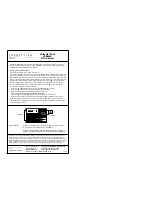
28
In order to minimize the interference from another buoy on the same frequency:
1.
The distance between the buoy and its receiver should be made as short as possible.
2.
At the same time, the distance between your receiver and the interfering buoy should be
made significantly larger than the distance mentioned under 1.
3.
1. and 2. apply to both buoy-receiver combinations.
Technical details:
The chance of getting erroneous data on the two data links depends on:
The distance between your buoy and your receiver and its propagation path.
The distance between the other buoy and your receiver and its propagation path.
The distance between your buoy and the other receiver and its propagation path.
The distance between the other buoy and the other receiver and its propagation path.
The amount of transmitted power of your buoy.
The amount of transmitted power of the other buoy.
The modulation type and protocols used for your buoy to receiver data link.
The modulation type and protocols used for the others buoy to receiver data link.
From this we see that predicting data link quality in an interference limited case is a specialist
job. At Datawell we developed a prediction tool for the case of one Datawell MKIII buoy
interfering with an other Datawell MKIII buoy over direct sea paths.
Datawell might able to help you with this tool when you are in trouble because of two MKIII
buoys interfering with each other on the same frequency.
A.4 Receiving antenna
The receiving antenna is the interface between the physical channel, namely the atmosphere and
the RX-D2 receiver. The antenna is connected to the RX-D2 using a low loss coaxial cable.
Contrary to the transmit antenna of the buoy we have at least some freedom to choose the
position and the height of the receiving antenna. The output signal level can be approximated as
follows:
Antenna
height
Signal level, relative to
an antenna height of 5 m
1m
-9 dB
2m
-6 dB
5m
0 dB
10m
+5 dB
20m
+8 dB
The signal level of the optional portable antenna is less than stated in the above table and
strongly depends on the position with respect to a ground-plane.
Содержание 45100
Страница 2: ...2 Check if mains supply matches with the specifications of the device...
Страница 4: ...4...
Страница 6: ...6...
Страница 8: ...8...
Страница 12: ...12...
Страница 20: ...20...
Страница 34: ...34 Appendix E Receiving antennas E 1 Standard groundplane antenna Figure E1 Standard groundplane antenna...
Страница 36: ...36 E 2 Directional Antenna 25 45 MHz Figure E3 Directional quarter wave antenna...










































